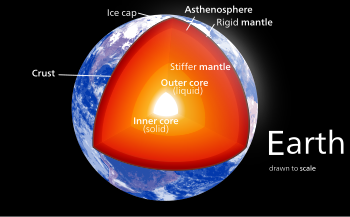
Back Magma Afrikaans ቅልጥ አለት Amharic Magma AN صهارة Arabic Magma AST Maqma Azerbaijani Магма Bashkir Magma BCL Магма Byelorussian Магма BE-X-OLD

Magma (from Ancient Greek μάγμα (mágma) 'thick unguent')[1] is the molten or semi-molten natural material from which all igneous rocks are formed.[2] Magma (sometimes colloquially but incorrectly referred to as lava by laypeople) is found beneath the surface of the Earth, and evidence of magmatism has also been discovered on other terrestrial planets and some natural satellites.[3] Besides molten rock, magma may also contain suspended crystals and gas bubbles.[4]
Magma is produced by melting of the mantle or the crust in various tectonic settings, which on Earth include subduction zones, continental rift zones,[5] mid-ocean ridges and hotspots. Mantle and crustal melts migrate upwards through the crust where they are thought to be stored in magma chambers[6] or trans-crustal crystal-rich mush zones.[7] During magma's storage in the crust, its composition may be modified by fractional crystallization, contamination with crustal melts, magma mixing, and degassing. Following its ascent through the crust, magma may feed a volcano and be extruded as lava, or it may solidify underground to form an intrusion,[8] such as a dike, a sill, a laccolith, a pluton, or a batholith.[9]
While the study of magma has relied on observing magma after its transition into a lava flow, magma has been encountered in situ three times during geothermal drilling projects, twice in Iceland (see Use in energy production) and once in Hawaii.[10][11][12][13]
- ^ "magma". Merriam-Webster.com Dictionary. Retrieved 2018-10-28.
- ^ Bowen, Norman L. (1947). "Magmas". Geological Society of America Bulletin. 58 (4): 263. doi:10.1130/0016-7606(1947)58[263:M]2.0.CO;2. ISSN 0016-7606.
- ^ Greeley, Ronald; Schneid, Byron D. (1991-11-15). "Magma Generation on Mars: Amounts, Rates, and Comparisons with Earth, Moon, and Venus". Science. 254 (5034): 996–98. Bibcode:1991Sci...254..996G. doi:10.1126/science.254.5034.996. ISSN 0036-8075. PMID 17731523. S2CID 206574665.
- ^ Spera, Frank J. (2000). "Physical Properties of Magma". In Sigurdsson, Haraldur (ed.). Encyclopedia of Volcanoes. Academic Press. pp. 171–90. ISBN 978-0126431407.
- ^ Foulger, G. R. (2010). Plates vs. Plumes: A Geological Controversy. Wiley-Blackwell. ISBN 978-1-4051-6148-0.
- ^ Detrick, R. S.; Buhl, P.; Vera, E.; Mutter, J.; Orcutt, J.; Madsen, J.; Brocher, T. (1987). "Multi-channel seismic imaging of a crustal magma chamber along the East Pacific Rise". Nature. 326 (6108): 35–41. Bibcode:1987Natur.326...35D. doi:10.1038/326035a0. ISSN 0028-0836. S2CID 4311642.
- ^ Sparks, R. Stephen J.; Cashman, Katharine V. (2017). "Dynamic Magma Systems: Implications for Forecasting Volcanic Activity". Elements. 13 (1): 35–40. doi:10.2113/gselements.13.1.35. ISSN 1811-5209.
- ^ MCBIRNEY, A. R.; NOYES, R. M. (1979-08-01). "Crystallization and Layering of the Skaergaard Intrusion". Journal of Petrology. 20 (3): 487–554. Bibcode:1979JPet...20..487M. doi:10.1093/petrology/20.3.487. ISSN 0022-3530.
- ^ Marshak, Stephen (2016). Essentials of Geology (5th ed.). W.W. Norton. p. 115. ISBN 978-0-393-26339-8.
- ^ Scientists' Drill Hits Magma: Only Third Time on Record, UC Davis News and Information, June 26, 2009.
- ^ Magma Discovered in Situ for First Time. Physorg (December 16, 2008)
- ^ Puna Dacite Magma at Kilauea: Unexpected Drilling Into an Active Magma Posters Archived 2011-06-06 at the Wayback Machine, 2008 Eos Trans. AGU, 89(53), Fall Meeting.
- ^ Teplow, William; Marsh, Bruce; Hulen, Jeff; Spielman, Paul; Kaleikini, Mike; Fitch, David; Rickard, William (2009). "Dacite Melt at the Puna Geothermal Venture Wellfield, Big Island of Hawaii" (PDF). GRC Transactions. 33: 989–994. Archived (PDF) from the original on 2022-10-09. Retrieved 8 February 2021.
© MMXXIII Rich X Search. We shall prevail. All rights reserved. Rich X Search